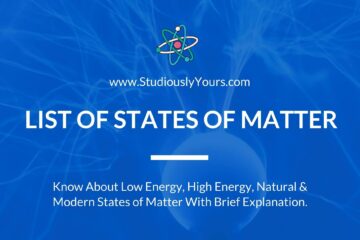Fundamental States of Matter – Matter can exist in different forms, these forms are called “states of matter”. On a daily basis, we come across 3 main states of matter known as solid-state, liquid state, and gaseous state of matter. But there are other states of matter as well, which are not observed as such in day-to-day life. These are considered intermediate states of matter and these states don’t exist in normal conditions. Two such states are plasma and Bose-Einstein condensate.
Trending: World Day to Combat Desertification and Drought: 17 June
Attempt Amazon Quiz Answers Today – Win Exciting Prizes Now!
Table of Contents
Why There Are So Many States of Matter?
Matter makes everything in this universe and hence it is called the “stuff” of the universe. Variations in the characteristics of particles of matter give rise to a variety of states of matter. In main states of matter (solid, liquid, gas), these variations are qualitative in nature and include changes in shape and volume. These changes arise due to variation in –
- spaces between the matter particles
- the motion of matter particles
- the attractive force (cohesion) of matter particles
External factors like pressure and temperature are also responsible for the variation of states of matter.
That’s not all, matter also has some exotic properties which give rise to some highly complex states of matter.
Click To Read – Lunar and Solar Eclipse Calendar 2022 – Know About 4 Eclplises of This Year
How Many States of Matter Are There 2022?
Given the vast range of variations in the properties of matter, there are more than three or five or seven states of matter. To count the number of known states of matter please have a look at this list. Moreover, all the states of matter can be grouped into two broad categories. These are –
- Low energy states of matter
- High energy states of matter
Check List of States of Matter Here.
Fundamental States of Matter
Solid, liquid, gas, and plasma are the four fundamental states of matter which can be observed easily in daily life. These are also called classical low energy states of matter.

Impotent Updates From Current Events In Science and Technology –
- NASA Parker Solar Probe
- Artemis Mission of NASA – A Journey To The Moon and Beyond
- NASA Earth Observation Satellites
- X Particles from the Dawn of Time Detected in Large Hadron Collider CERN
Solid
Particles of matter in the solid-state are packed tightly (highly dense) and are under constant vibratory motion (periodic back-and-forth motion). Vibrations of solids are very small and hence solid possess very less kinetic energy. Due to the locked-in position of the particles, solids are not compressible and hence are rigid.
Solids are of definite shape and volume. To make changes in its shape and volume an external force is required.
Most solids that we encounter oftentimes are crystalline in nature these are salt, sugar, minerals, and diamonds. At room temperature wood, metal and rock, etc. are also solids.
When heat energy is provided to solids they melt to convert into liquid.
Liquid
Constituent particles in the liquid state of matter are loosely packed compared to that of the solids. These particles can flow around easily (slide past one another) and have more kinetic energy than solids.
Liquids have a definite volume but indefinite shape. When kept in a container liquid conform to its shape.
When a solid rock is heated up it starts to liquefy and is converted into molten lava. Water at room temperature is liquid.
Note: Given the proximity among the matter particles, liquid and solid states of matter are often referred to as condensed phases.
Gas
Ever wondered why is gas a fundamental state of matter? Particles of gases have high kinetic energy. Gases have an indefinite shape as well as volume and assume the shape and volume of the container.
Gases have a lot of inter-particle space and hence gases are highly compressible. This feature helps in the convenient transportation of gases.
LPG (Liquefied Petroleum Gas), used in homes for cooking, CNG (Compressed Natural Gas), used in vehicles, Oxygen gas, used in hospitals are compressed in a cylinder for convenient storage and transportation.
So if anyone askes – What are the three fundamental state of matter? The answer would be – Solid, Liquid and Gas.
You May Also Like To Read These Articles –
- Chain-melted state – A new state of matter discovered
- Standard Model of Particle Physics – Explained
- New definition of Kilogram and other SI units
The following table shows a comparative analysis between solid, liquid and gaseous states of matter.
| Properties | Solid | Liquid | Gas |
|---|---|---|---|
| Shape | Definite | Indefinite | Indefinite |
| Volume | Definite | Definite | Indefinite |
| Compressibility | Highly incompressible | Nearly incompressible | Compressible |
| Force between constituents particles | Strong | Weak | Negligible |
| Kinetic energy of constituents particles | Very less | Less | High |
| Density | High | Less | Very less |
To visualize these states of matter using this great resource – states of matter animation.
Plasma
Just like gases, matter in the plasma state has an indefinite shape and volume. What differentiates plasma from gases is electrical conductivity. Plasma is ionized gas in which positively charged nuclei swim in a “sea” of freely-moving disassociated electrons. The plasma state is not observed on earth easily but it is the most common state in the universe.
There are two ways by which gases are converted into plasma.
- By ionizing a gas when subjected to huge voltage difference
- By creating extremely high temperature
Sun’s corona can be understood as a big plasma ball. On earth, plasma can be observed in lightning, electric sparks, fluorescent and neon lights, and in plasma TV.
Quick question, are there only 4 fundamental states of matter? Quick answer – No!

Bose-Einstein Condensate
Apart from the four fundamental states of matter, this is another well-known state of matter. Sometimes referred to as the fifth state of matter, Bose-Einstein condensate is opposite to that of the plasma. In plasma, the temperature is very high and the particles are in a highly excited state, whereas, in Bose-Einstein condensate, the temperature is very low and matter particles are in a highly unexcited state. These conditions are so critical that the matter particles are in the lowest quantum state.
Bose-Einstein condensate is named so because it was initially proposed by Albert Einstein followed by important statistical calculations done by Satyendra Nath Bose.
Bose-Einstein condensate was first created in 1995 by two scientists Eric Cornell and Carl Weiman using the clumping of matter particles.
The importance of studying BEC lies in its usage. It is used in studying quantum mechanics on a macroscopic level.
Conclusion – Fundamental States of Matter
Science and discovery are unstoppable and hence the introduction of a new state of matter should not come as a surprise. But yes, talking about the fundamental states of matter then we have solid, liquid, gas, and plasma, followed by the fifth man-made state of matter called Bose-Einstein condensate. To know as to how many states of matter are there in the universe? It is still a long way to go!
Fundamental States of Matter FAQs
In most basic form, the matter is found in some specific phases which are called fundamental states of matter.
Solid, liquid, gas are the most common example of states of matter.
The 3 fundamental states of matter are solid, liquid and gas.
The 4 fundamental states of matter are solid, liquid, gas and plasma.
Plasma is the fourth state of matter, the fifth state of matter is called Bose-Einstein condensate.
The newest state of matter is called “liquid glass”. It is like a gel that lies between solid and colloid.
The ancient Greeks are considered to have identified the first state of matter.
Check Below Tabs For More Amazing Content.



0 Comments